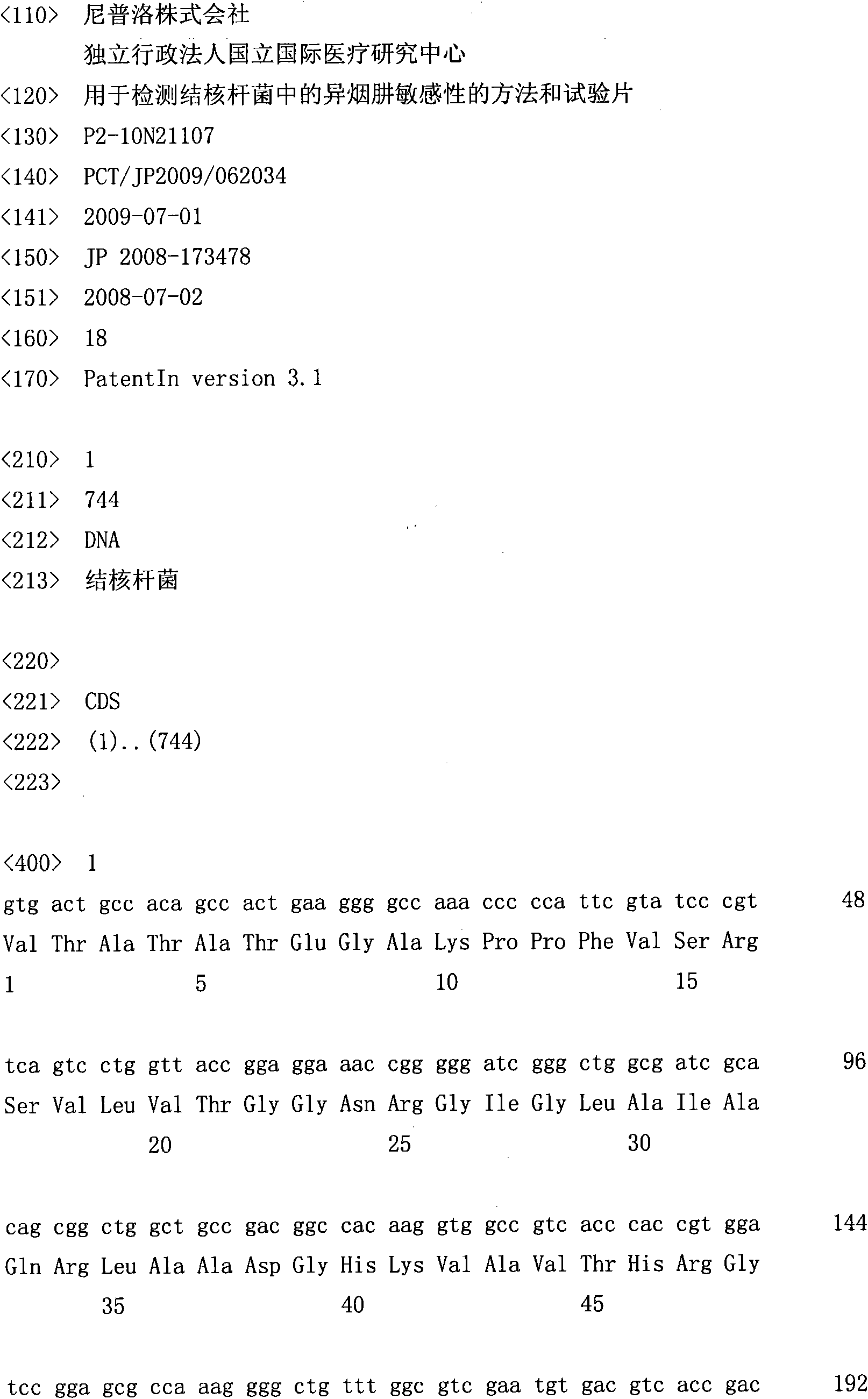Method and specimen for detecting sensitivity to isoniazid in tubercle bacillus
A technology of Mycobacterium tuberculosis and test strips, applied in biological testing, material inspection products, biochemical equipment and methods, etc., can solve problems such as inability to detect, and achieve the effect of appropriate treatment and accurate detection
- Summary
- Abstract
- Description
- Claims
- Application Information
AI Technical Summary
Problems solved by technology
Method used
Image
Examples
Embodiment 1
[0090] (Example 1: Analysis of Mycobacterium tuberculosis genes of INH-resistant Mycobacterium tuberculosis)
[0091] In this example, 92 specimens were obtained, and these 92 specimens were obtained by confirming that they were in a solution containing INH (MGIT 960: manufactured by Becton Dickinson Japan Co., Ltd.) or an agar medium containing INH (Ogawa medium, 7H10) Genomic DNA was extracted and purified from these 92 specimens grown and judged to be INH-resistant Mycobacterium tuberculosis by the phenol extraction method.
[0092] 1. Analysis of fabG1 gene
[0093] The fabG1 gene was amplified using the primer pair shown below. The PCR reaction conditions are as follows: denaturation process at 94° C. for 30 seconds, annealing process at 55° C. for 20 seconds, and chain extension process at 72° C. for 20 seconds. This step is repeated 30 times to amplify the fabG1 gene.
[0094] fabG 1 primer 1 ggctacatcg acaccgatat gacc (SEQ ID NO: 6)
[0095] fabG 1 primer 2 gcgtcctt...
Embodiment 2
[0110] (Example 2: Preparation of test piece)
[0111] 1. Probe Design
[0112] As probes capable of detecting INH sensitivity of Mycobacterium tuberculosis, the following two probes (probes 1 and 2: fabG1 wild-type probe and furA wild-type probe, respectively) were designed. Both of these probes are wild-type probes that do not bind but only bind (hybridize) to the wild-type gene in the presence of mutations.
[0113] Probe 1 ggggcgctgc aatttatccc (SEQ ID NO: 3)
[0114] Probe 2 gctccggacg gccgacctgc g (SEQ ID NO: 10)
[0115] 2. Immobilization of probes
[0116] Using terminal transferase (Promega), poly T was added to each of the 5' ends of the above probes 1 and 2 (see SEQ ID NO: 3 and SEQ ID NO: 10, respectively). Specifically, 0.4 μL (30 units / μL) of terminal transferase, 2 μL (10 pmol / μL) of thymidine triphosphate, 2 μL (50 mM) of oligonucleotide probes, 2 μL of reaction buffer supplied with the product, and 3.6 μL of purified Water was mixed to prepare a reaction ...
PUM
 Login to View More
Login to View More Abstract
Description
Claims
Application Information
 Login to View More
Login to View More - R&D
- Intellectual Property
- Life Sciences
- Materials
- Tech Scout
- Unparalleled Data Quality
- Higher Quality Content
- 60% Fewer Hallucinations
Browse by: Latest US Patents, China's latest patents, Technical Efficacy Thesaurus, Application Domain, Technology Topic, Popular Technical Reports.
© 2025 PatSnap. All rights reserved.Legal|Privacy policy|Modern Slavery Act Transparency Statement|Sitemap|About US| Contact US: help@patsnap.com



